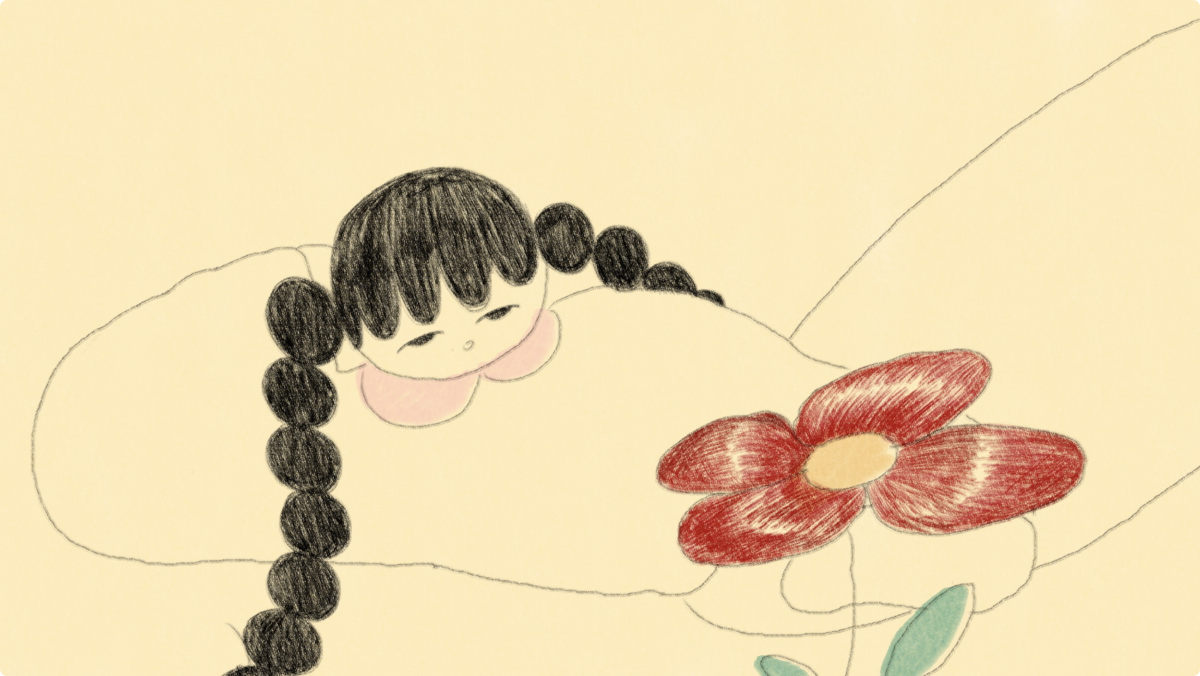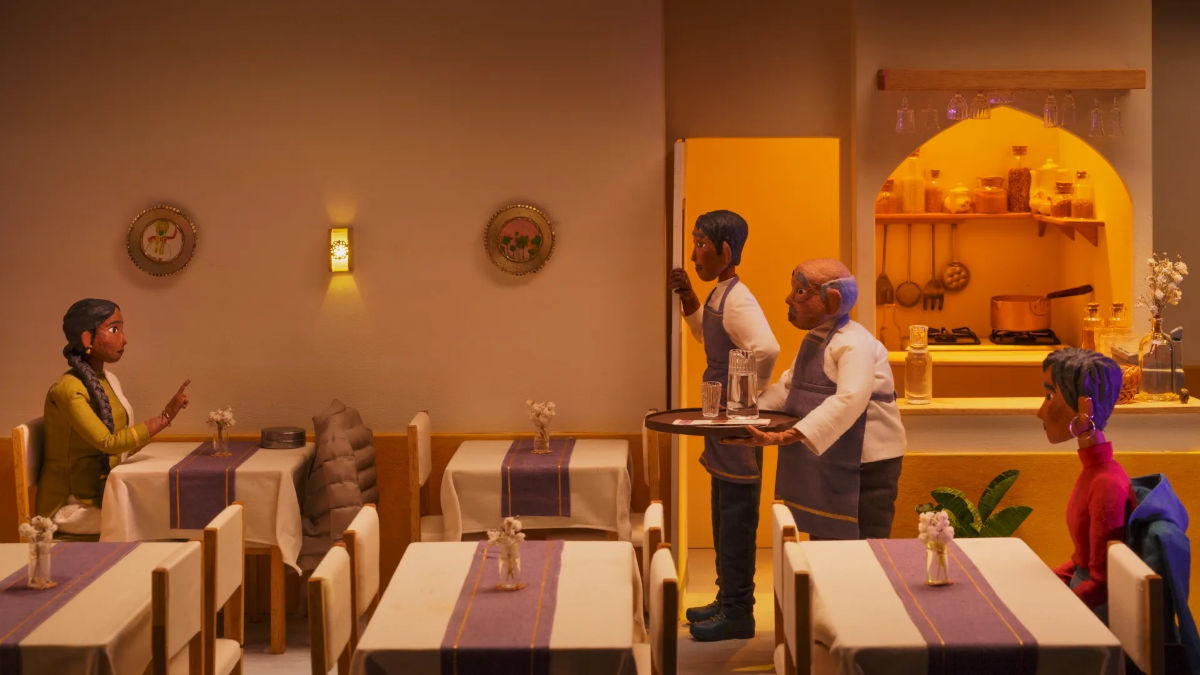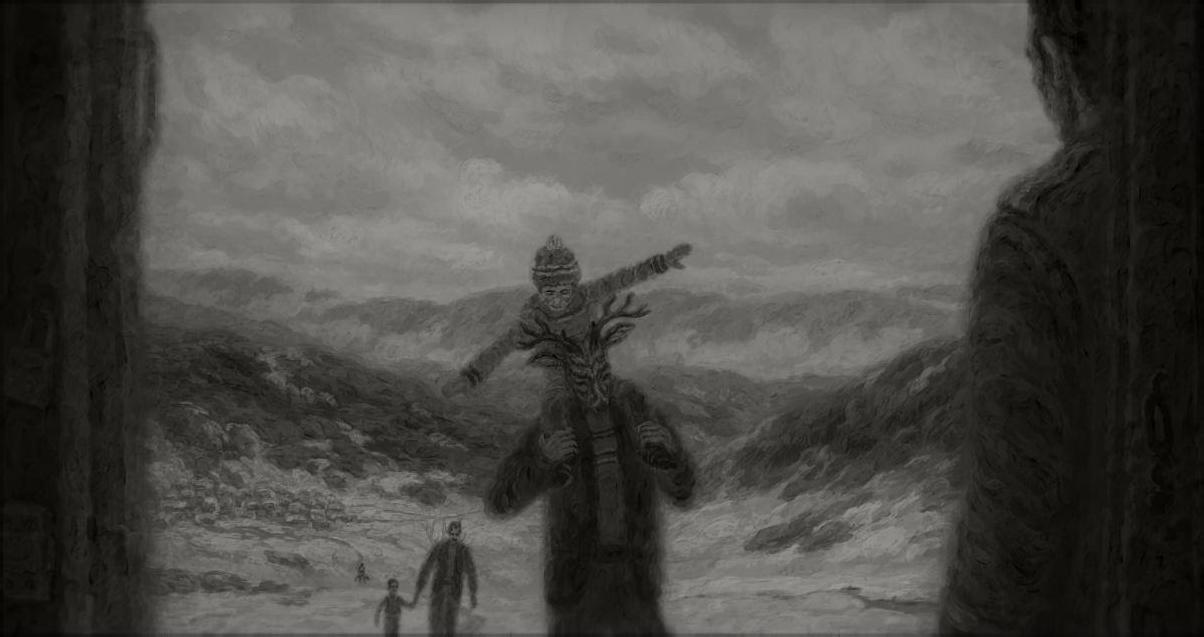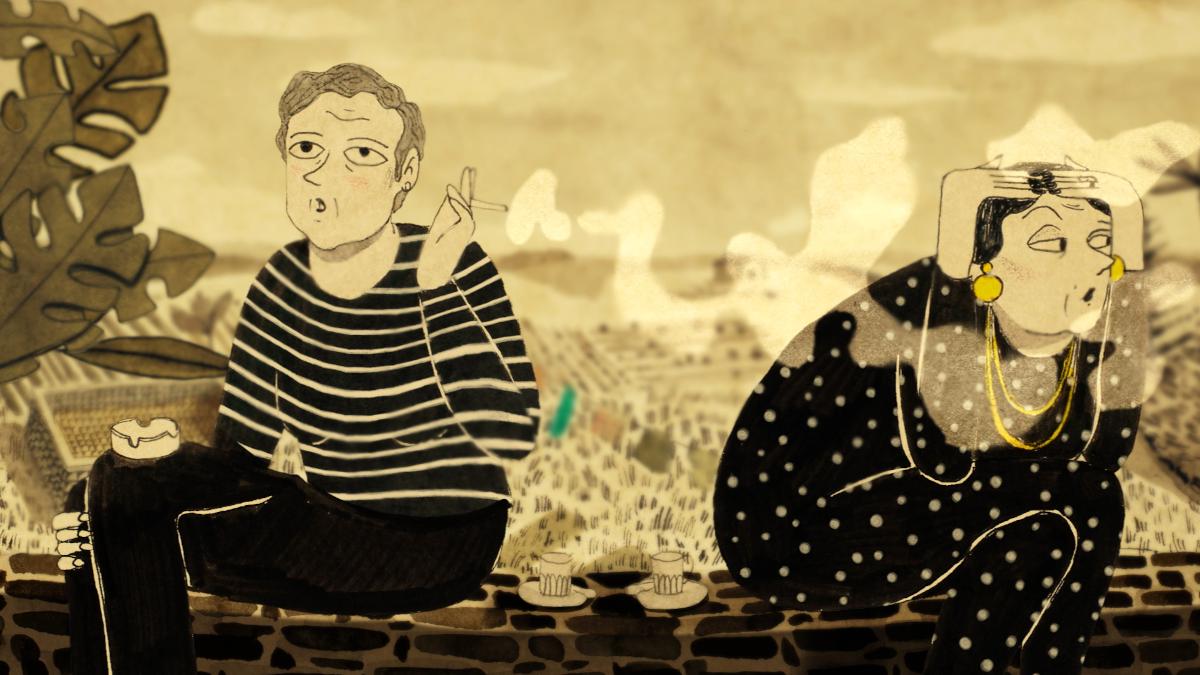Independent Animation Shorts
Signs by Dustin Rees: Online Premiere
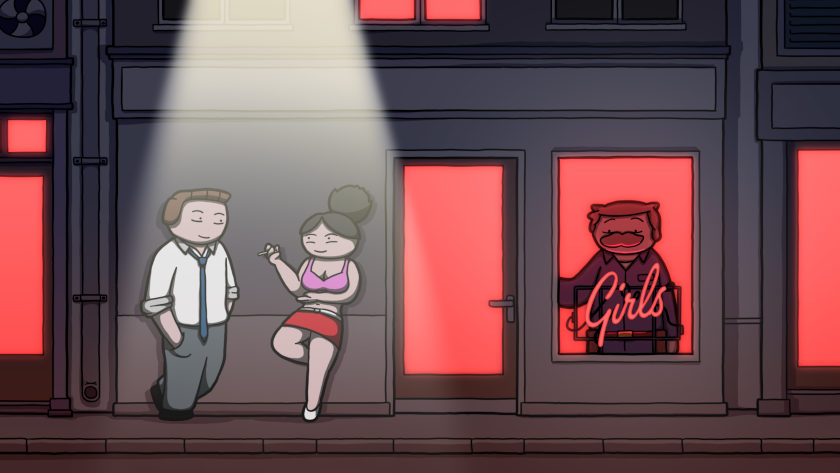
Swiss animation artist Dustin Rees does many things, from animation director to image projectionist to being an HSLU teacher and a dad. His 2020 2D animation, 10-minute short 'Signs' (produced by Virage Film) comes off after a series of short films, commissioned films, clips, and trailers. The film had a big festival career (from Shanghai International Film Festival to Montreal's Sommets du cinema d'animation), winning the Audience Award in Swiss Competition at Fantoche (2020), and a Special Mention at the Countryside Animafest Cyprus 2020 festival -among other prizes.
The story has an electrician following his night routine setting up signs in the city, until he realizes they are different signs he should be paying attention to. Dustin Rees talked to Zippy Frames.
ZF: This is a relationship story told through night signs. Does it have a personal origin for you, and was it an experience you wanted to reproduce on the screen?
DR: Indeed, it does! I also work as a cinema projectionist, so I’d often be out working in the evenings and missing my girlfriend as she’d come home from work. But generally, I feel that we - that is humans - are often terribly busy, so it is a theme we can all relate to. Finally, too, 'Signs' (as well as the birth of our first son and Covid following the film's release) certainly helped me to focus on what is important.
ZF: What kind of research did you have to do to depict the nightlife of a city? Relatedly, how did you choose which night scenes to depict (sex workers, football matches, cinema) and which ones to leave out?
DR: Finding the locations was somewhat of a challenge. On the one hand, I wanted certain things to “happen” to the electrician, (get pushed, ignored, turned about, lose something, etc.) and on the other hand, I needed the places that have a sign, and are open at night. Some came by more easily; for instance, the hotel, which was based on the Drake Hotel in Chicago which I had visited. Hoppers Bar felt like an opportunity to jump on the bandwagon and quote, as so many have before. The cinema is a combination of a cinema I worked at, and the sign from Giuseppe Tornatore’s 'Cinema Paradiso'. Actually, apart from the restaurant, all places had a heavy reference to something or someplace I knew very well.
Discarded locations, included a park, as they seldom have a lit sign. As well as an underground subway exit, because the scenario/action that would have occurred was too similar or better in other places.
A video diary of 'Signs':
ZF: Lighting in the film plays a most important role, but it has this on/off switch quality. Was it meant to be that way?
DR: Very much so ;) I wanted the locations to be either dark or light, off or on, closed or open, or (being overly dramatic) dead or alive. The idea was that the electrician works unseen by the general public, and when the switch is turned on, he - even though he himself is responsible for the location being active - is not a part of the event. Some scenes start with the switch, and others have the switch integrated within them. All scenes however had to have (even if only for a few frames), an off-and-on setting. Which of course meant double the work for lighting and colouring the scenes. I always wanted 'Signs' to be a colorful film, even though it basically takes place at night. The most important scenes (the office and their room) are the only ones to be fully lit or in daylight. These two scenes also held the obvious messages of the film. “Read the signs”, for his realization as to what had happened at the only place he turns off the electricity. “Shedding light on the subject” to enable him and her to address their issues at the end of the film.
ZF: Your character designs reveal your characters as the next-door neighbors. Did anything trouble you in the character design and in the subsequent animation process?
DR: Brilliant, thank you! I certainly wanted to have the audience invoke an empathy towards my characters, making them everyday people. I never give my characters names either. It’s one of the advantages of animation anyway, never seeing the actor but rather the character. So not having names makes them more accessible to the audience. Nothing really troubled me in the animation in itself. Most of the movements are fairly simple, very calm, slow, or subtle. The only truly difficult scenes were the getting thrown out of the hotel door, and the group choreography at the club. Luckily I had very talented animators, who covered those scenes.
Watch 'Signs' by Dustin Rees
ZF: Sound design needs to depict the big city with its noise etc. Was that an easy thing to accomplish?
DR: I was fortunate to have an amazing team on the audio. Everyone was dead set on giving any and every detail an accurate sound, no matter how subtle. As the film has very little music (which of course makes the music that is there, even more important), it relies on the audience to listen (and observe), without the aid of a mood set by music or dialogue. So we paid a lot of attention to get the most out of the sound design. Police cars passing by their window, the early morning traffic queues, the football fans demolishing a car window off-screen… it may sound difficult, but I believe we all were eager and had a lot of fun, which made it easy.
ZF: Can you alert us on the production schedule for the film (how long from development to completion), and any relevant collaborators?
DR: I had the original idea back in 2012 (the wish to do a film with neon signs). I started working with Saskia von Virág, the film's producer, in 2016. The story started out as something very different. We also had to resubmit tofunders until production itself started beginning in 2018. The film was finished in February 2020, with the help of Vanja Andrijevic from Bonobostudio the festival run could get started. A bit of a setback was, that I had somewhat underestimated the first home sequence (the first night), it turned out to be treble the length, which put us back some months. Every collaborator was relevant, but if I had to mention one in particular it would be Konstantin Bronzit, who told me no good director would touch my script - and he was right, the first draft was a mess!
ZF: 'Signs' is a no-dialogue film that successfully tells a story from beginning to end. Do you think that animation and its short format don't need dialogue or was it for this specific story that the whole thing worked?
DR: I generally believe a film dictates what it needs, be that dialogue, character, staging, or technique. Animation does have the added workload of lip-syncing. That and of course all the other factors that go into dubbing and subbing a film, certainly make one consider the no-dialogue option. But no, I do not believe that animation, short or feature, does not need dialogue. :)
That said, 'Signs' I think, however, doesn't need dialogue - the puns taking over again: it’s all about reading the signs. I did not want the audience to be spoken to, they needed to pay attention. I actually make them “suffer” through the first night (3 minutes of a 10-minute film), following the couple in “real-time” (apart from the 3 jump-cuts) just to become aware of their routine. I wanted the observation to be experienced rather than spoken because this is what sets up the following actions (her being fired, his realization of that, etc) non-verbally. That’s what makes the most sense to the story - the film dictates.
ZF: You have made animation films before, both commissioned and artistic. Do you regard 'Signs' as an advancement on your previous work or simply a different experience? And what comes next for you?
DR: I do have a recurring theme in my films. Most of the time they are about “unseen” characters. 'Signs' has that too, but on a new level. As mentioned in the previous answers, it’s been a play on that topic. I feel I truly had something to say (which was: “wake up and smell the daisies” basically), and staged it in a way that doubles down on the theme. 'Signs' has been a passion project, and I threw everything I had into it. I’m immensely proud of the concept and story. Much like in the film, I’m really hoping I’ll be lucky enough to follow a path doing the things I believe are worth pursuing.
Dustin Rees (now a second-time, stay-at-home dad) also had a Xmas gift (available from 6 December) on an animated advent calendar.
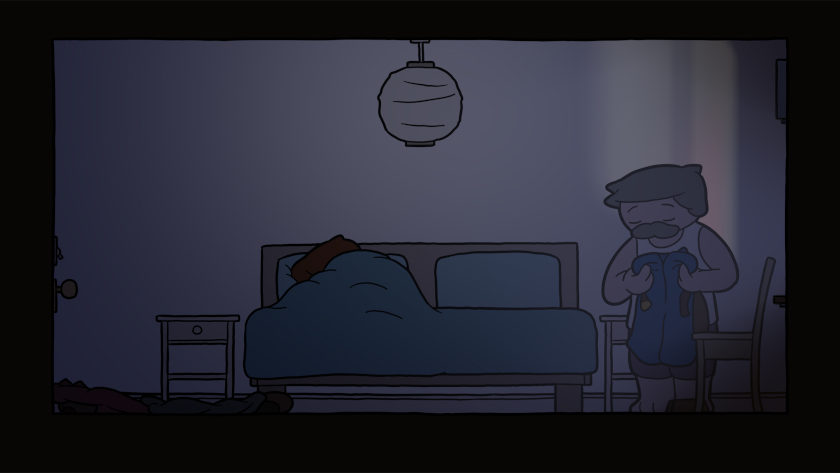
Film Review (Vassilis Kroustallis):
'Signs' is both an animated night job chronicle and a relationship parable at the same time. It tells its bittersweet story of a relationship long left in the 'sleep' mode, and it has a fitting economy of scenes to both narrate the expected -and make us hope that the unexpected will arise after all. Its main character travels the world as the everyday (every night) man, merely an observer and a mindless actor. At the same time, his environment ranges from the casual to the somewhat dangerous -and sounds perfectly capture this tension. With a very relatable character design, the film's visual environment contrasts day and night, as if they were enemies fighting for the electrician's soul. 'Signs' grasps the bad routine vibes and transforms them gleefully into a bedroom marital scene -soon to be lit again. A film that lights you up.
About Dustin Rees
* 1981. Zurich-born Dustin Rees grew up in the UK before returning to Switzerland in 1991. In 2007 he graduated from the Lucerne School of Art and Design (HSLU). He has directed and produced numerous commissioned trailers, clips and short films, as well as executing his own projects. Additionally, he teaches at the HSLU, runs film and animation workshops, and is a film projectionist in various cinemas. His films 'Signs' (2020), 'Ransom' (2012), 'Borderline' (2011) and 'The Bellringer' (2007) screened at numerous festivals.
CREDITS:
Signs (2020), a film by Dustin Rees
produced by Saskia von Virág | animation Dustin Rees, Yael Schärer, Jonathan Wüst | story consulting Rachel Schmid | editing consulting Fee Liechti Seigner, Rolf Lang | additional shadowing Géraldine Cammisar | additional coloring Jolanda Oswald | additional compositing Stefan Holaus | sign designs Barney Rees | mastering & dcp Redspace – Rolf Lang, Dominique Gasche | music Olav Lervik | sound design & mix Noisy Neighbours – Loïk Kreyden, Thomas Gassmann | foley Dieter Hebben | mastering Magnetix – Guido Keller | production Virage Film | in co-production with SRF Swiss Radio and Television – Gabriela Bloch Steinmann




